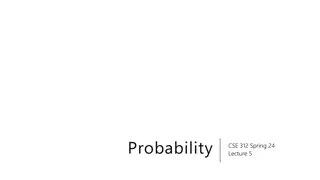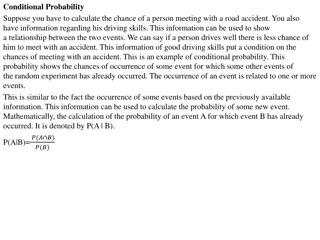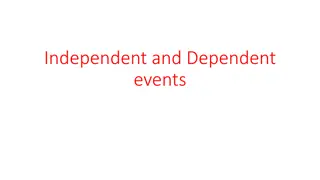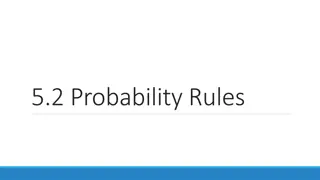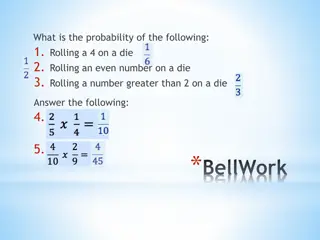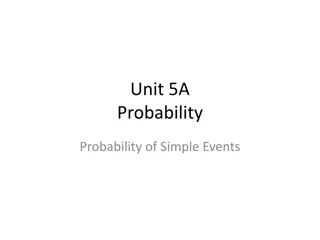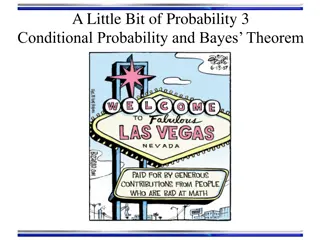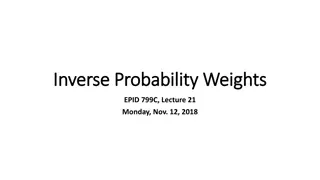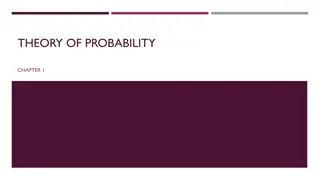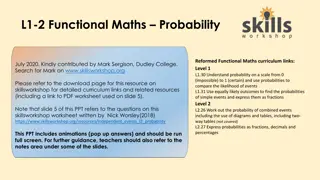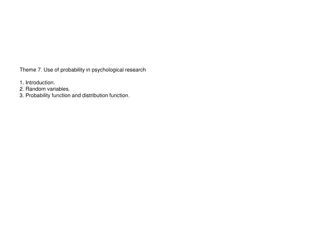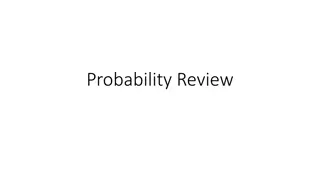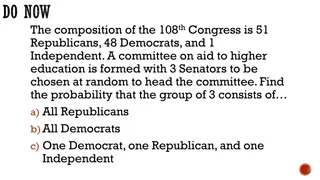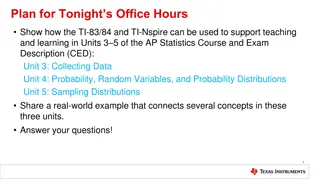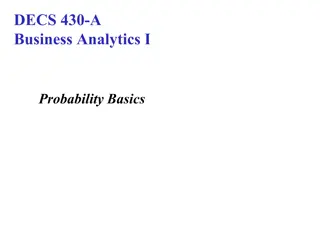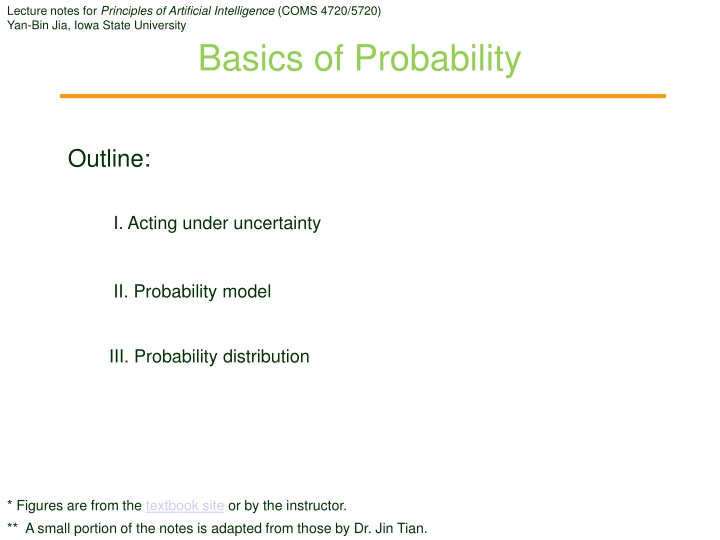
Principles of Artificial Intelligence: Basics of Probability & Uncertainty
Explore the fundamentals of probability and uncertainty in the context of artificial intelligence, covering topics such as acting under uncertainty, probability models, belief states, uncertain beliefs, dental diagnosis, reasoning under uncertainty, and probability basics.
Download Presentation

Please find below an Image/Link to download the presentation.
The content on the website is provided AS IS for your information and personal use only. It may not be sold, licensed, or shared on other websites without obtaining consent from the author. If you encounter any issues during the download, it is possible that the publisher has removed the file from their server.
You are allowed to download the files provided on this website for personal or commercial use, subject to the condition that they are used lawfully. All files are the property of their respective owners.
The content on the website is provided AS IS for your information and personal use only. It may not be sold, licensed, or shared on other websites without obtaining consent from the author.
E N D
Presentation Transcript
Lecture notes for Principles of Artificial Intelligence (COMS 4720/5720) Yan-Bin Jia, Iowa State University Basics of Probability Outline: I. Acting under uncertainty II. Probability model III. Probability distribution * Figures are from the textbook site or by the instructor. ** A small portion of the notes is adapted from those by Dr. Jin Tian.
Drawbacks of Using Belief States Keeping track of a belief state has several drawbacks: Large belief state full of unlikely possibilities because every possible explanation of the percept needs to be considered. Correct contingent plan growing arbitrarily large to handle every eventuality. No successful plan guaranteed sometimes yet action required. There needs to be a way to compare the merits of plans that are not guaranteed. Make a rational decision depending on relative importance of various goals, and likelihood that, and degree to which, they will be achieved.
From Categorical to Uncertain Beliefs Intelligent behavior requires knowledge about the world. Propositional and first-order logics are effective for representing and reasoning with categorical beliefs about the world. Due to uncertainty, any logical sentence could be true, false or unknown. Logical approach can break down.
Dental Diagnosis // Wrong rule as some patients with toothaches // have no cavity but gum disease, an abscess, Toothache Cavity Toothache Cavity GumProblem Abscess // We would have to add an almost unlimited list of possible problems. Cavity Toothache // Still not right since not all cavities cause pain. Fix the rule by augment the LHS with all qualifications required for a cavity to cause a toothache! Too much work. Medical science has no complete domain theory. Not all the necessary tests have been or can be run on a patient.
Example of Reasoning Under Uncertainty Beliefs If a patient has lung cancer, there is a 60% chance that an X-ray test will come back positive; and a 40% chance negative. If a patient does not have lung cancer, there is 2% percent chance that an X-ray test will come back positive ; and a 98% percent chance negative. Population cancer rate is 1/1000. Observation X-ray test came back positive. Inference task What is the chance that the patient has lung cancer? Probability theory provides a framework for representing and reasoning under uncertainty.
II. Probability Basics Probability deals with chance experiments that have a set of distinct outcomes or possible worlds ( is called the sample space). Roll a die: = {1,2,3,4,5,6} Toss a coin: = {head, tail} Roll two dice: = { 1,1 , 1,2 , , 1,6 , , 6,1 , ,(6,6)} ? is a sample point, possible world, or atomic event. mutually exclusive exhaustive
Probability Model A probability space associates a probability ?(?) with every possible world ?: 0 ?(?) 1 ? ? = 1 ? Roll two dice: = {(1,1),(1,2), ,(6,6)} If both dice are fair, then each possible world has probability 1/36. If the dice are loaded, then the worlds will have uneven probabilities that still sum to 1. ? ? = ?(?) An event (or proposition) ? is a subset of . ? ? ? = {2,4,6} is the event that the result of rolling one die is an even number. ? ? = ? 2 + ? 4 + ? 6 = 1/2 ? is the event that the results of rolling two dice summing to 10. ?(Total = 10) = ? ? = ? (4,6) + ? (5,5) + ? (6,4) = 1/12
Prior vs. Posterior Probabilities The prior (or unconditional) probability of an event is in the absence of any other information. ?(Total = 10) = 1/12 Often some evidence has already been revealed. The posterior (or conditional) probability of an event (i.e., proposition) ? given an event ? with ?(?) > 0 is ? ? ?) =?(? ?) ?(?) ? refers to the appearance of 4 on a die, and ? refers to the appearance of an even number. ? ? ?) =1/6 1/2=1 3 The prior of ? is 1/6, and the posterior of ? given ? is 1/3.
Prior vs. Posterior (contd) Go to a dentist for a regular checkup. Consider the prior probability: ?(cavity) = 0.2 Go to a dentist because of a toothache. Consider the posterior probability: ?(cavity | toothache) = 0.6 If the dentist finds no cavities, we would not want to conclude the above posterior: ?(cavity | toothache cavity) = 0 The product rule: ? ? ? = ? ? ?)?(?)
Random Variable A random variable (RV) is a function from the sample space to some range the set of possible values (e.g., real or Boolean) it can take on. // The name of a random variable begins with an upper-case letter. The range of value for one die is {1, ,6}. The range of Total for two dices is {2, ,12}. The range of Weather might be {sun, rain, cloud, snow}. The range of the resistance ? of a resistor can be (0, ). Inequality range: NumberOfAtomsInUniverse 1070. A probability space ? induces a probability distribution for any random variable ?. ? ? = ? = ?(?) ?:? ? =? ? Even = true = ? 2 + ? 4 + ? 6 = 1/2
Use of Proportional Logic For a Boolean random variable A, we abbreviate proportions A=true and A=false as ? and ?, respectively. // The probability that the patient has a cavity, given that // she is a teenager with no toothache, is 0.1. ? cavity toothache teen = 0.1 ? cavity toothache,teen = 0.1 Often in AI applications, random variables are basic elements. The sample points are the values of a set of random variables. A possible world is an assignment of exactly one value to every random variable. Example 4 distinct atomic events (or 4 possible worlds): cavity toothache cavity toothache cavity toothache cavity toothache
III. Probability Distribution Probabilities of all the possible values of a random variable. ?(Weather = sun) = 0.6 ?(Weather = rain) = 0.1 ?(Weather = cloud) = 0.29 ?(Weather = snow) = 0.01 abbreviated as ?(Weather) = 0.6,0.1,0.29,0.01 Probability distribution: ? ? ?) gives the values of ? ? = ?? ? = ??} for all ?,?. // The distribution is represented as a two-dimensional array.
Joint Probability Distribution Joint probability distribution gives the probability of every atomic event on a set of RVs (i.e., every combination of their values). ? Weather,Cavity is a 4 2 matrix. Weather sun rain cloud snow Cavity true false 0.144 0.02 0.016 0.02 0.576 0.08 0.064 0.08
Concise P Notation ? Weather,Cavity = ? Weather | Cavity? Cavity {true, false} {sun, rain, cloud, snow} replaces 8 equations (corresponding to 8 possible worlds) ? ? = sun ? = true = ? ? = sun ? = true ?(? = true) ? ? = rain ? = true = ? ? = rain ? = true ?(? = true) ? ? = cloud ? = true = ? ? = cloud ? = true ?(? = true) ? ? = snow ? = true = ? ? = snow ? = true ?(? = true) ? ? = sun ? = false = ? ? = sun ? = false ?(? = false) ? ? = rain ? = false = ? ? = rain ? = false ?(? = false) ? ? = cloud ? = false = ? ? = cloud ? = false ?(? = false) ? ? = snow ? = false = ? ? = snow ? = false ?(? = false)
Kolmogorovs Axioms 1. for every world ? . 0 ?(?) 1 ? ? = 1 2. ? 3. for any two propositions ?, ?. ? ? ? = ? ? + ? ? ?(? ?) counts ? ? twice. The rest of probability theory are built up from these axioms.
Inconsistent Beliefs Agent 1 will lose $6 if ? = ? Agent 2 will lose $4 if ? Agent 1 has inconsistent beliefs since 0.8 = ? ? ? > ? ? + ? ? = 0.7 Agent 2 can devise a set of bets to guarantee a win. No rational agent can have beliefs that violate the axioms of probability (following De Finetti s theorem). For more on basics of probability, see https://faculty.sites.iastate.edu/jia/files/inline-files/probability.pdf.

